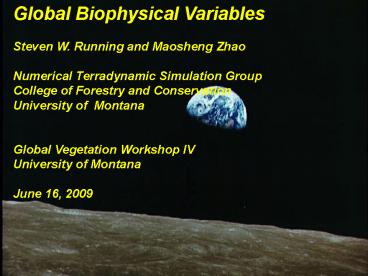Global Biophysical Variables PowerPoint PPT Presentation
1 / 33
Title: Global Biophysical Variables
1
Global Biophysical Variables Steven W. Running
and Maosheng Zhao Numerical Terradynamic
Simulation Group College of Forestry and
Conservation University of Montana Global
Vegetation Workshop IV University of
Montana June 16, 2009
2
From Richard Fernandez
3
- Terrestrial Carbon Monitor
Change
State
LANDCOVER
SATELITE DATA
GROWING SEASON
PRIMARY PRODUCTION
GROUND DATA
4
MODIS GPP/NPP vs Fluxtowersacross 9 Biomes
From D.P.Turner et al. Remote Sensing of Env
102282-292. 2006
5
(No Transcript)
6
(No Transcript)
7
NPP ofWestern Montana
Missoula
8
Uncertainties in the MOD17 (GPP/NPP) Algorithm
1. Meteorological DAO IPAR, Temperature,
VPD 2. Radiometric MODIS FPAR and LAI 3.
Ecological MOD17 representation of plant
physiology (BPLUT) Accurate mapping of landcover
typeEach of these requires a different mode of
validation.
9
Annual Cloudcover Percentage for MODIS
10
Spatial pattern of MODIS total NDVI trend from
2000 to 2008
11
Spatial pattern of MODIS total EVI trend from
2000 to 2008
12
Spatial pattern of MODIS total FPAR trend from
2000 to 2008
13
Spatial pattern of MODIS total LAI trend from
2000 to 2008
14
Correlation between total EVI and NDVI (2000 to
2008)
15
Correlation between total FPAR and NDVI (2000 to
2008)
16
Correlation between NPP and total NDVI (2000 to
2008)
17
Correlation between NPP and total EVI (2000 to
2008)
18
Correlation between NPP and total LAI (2000 to
2008)
19
Correlation between NPP and total FPAR (2000 to
2008)
20
Spatial pattern of MODIS NPP trend from 2000 to
2008
21
NPP reduced in 2005 drought in Amazon despite
high EVI
- Field data support reduced NPP in 2005 (Phillips
et al., 2009 Science)
22
Global anomalies of NPP vs. inverted sea level
CO2 annual growth rate
- Correlation of NPP by NCEP-II and inverted CO2
annual growth rate is 0.89 (2000-2008) - Correlation of NPP by GMAO and inverted CO2
annual growth rate is 0.82 (2000-2006)
23
Spatial pattern of the 0.05-resolution global
MODIS ET anomalies during 2000-2005
24
Comparison of annual latent heat flux (LE)
observations from 19 AmeriFlux sites and the ET
estimates averaged over the MODIS 3 ? 3 km
cutout. These data were created using (a)
tower-specific meteorology and (b) the global
GMAO meteorology.
25
Influence of disturbance on net carbon
exchange, relative to interannual climate
variation and increasing CO2
26
GLOBAL Generalized Disturbance Index
Mildrexler et al 2006
Mildrexler et al 2006
27
Current global landcover measures are limited by
inconsistent data, and imprecise classification
logic What is needed is a climatically relevant
measure of landcover change
28
2006 MODIS Disturbance Index
Disturbance Rate 1.1 2.5/yr
29
Trajectory of Global Fossil Fuel Emissions
50-year constant growth rates to 2050 B1
1.1, A1B 1.7, A2 1.8 A1FI 2.4
Observed 2000-2006 3.3
Raupach et al. 2007, PNAS
30
Fate of Anthropogenic CO2 Emissions (2000-2007)
1.5 Pg C y-1
Canadell et al. 2007, PNAS (updated)
31
- NEE
- and Carbon credits
- Vs
- NPP
- and Biofuels
It may be possible to do both and verify results
32
TWO MONITORING/VERIFICATION IDEAS
- First, a standard global map of maximum NEE for
any landarea so carbon offset potential cannot be
inflated.
Second, an annual satellite derived global
landcover change measure as an independent
monitor that C offsets are intact.
33
Would you invest 100,000,000,000 based on this
information???

